FEATURE ARTICLE 2: SHORT-TERM OVERSEAS TRAVEL TO AND FROM WESTERN AUSTRALIA
INTRODUCTION
There has been a large rise in Western Australians travelling overseas since 2003, underpinned by a rapidly expanding local economy. More people have departed Western Australia for holidays, visiting friends or relatives, business, education, employment and conventions or conferences. Overseas holiday travel has increased substantially to Thailand, Singapore and Malaysia. Thailand, in particular, has emerged as a major holiday destination since the impact on travel to Indonesia after the Bali bombings in 2002-2005. The number of Western Australians travelling overseas to visit friends or relatives surged to a ten-year high in 2006, with much more travel to the United Kingdom and New Zealand. Overseas business travel from Western Australia has grown strongly, particularly to the rapidly developing countries of China, India and the United Arab Emirates. Education travel and convention or conference travel have also risen sharply since 2003, with many more Western Australian students departing to Singapore and New Zealand and convention or conference travel rising, predominantly to China. Employment travel abroad has showed a modest increase due to the onset of the state's skills shortage.
Travel into Western Australia has increased more modestly than outbound travel over the ten years to 2006. Holiday travel from Asia has been hampered by the 1997 Asian financial crisis, terrorists attacks and natural and biological disasters, particularly from Indonesia, Malaysia and Thailand. However, there have been notable increases in the amount of travel to Western Australia for employment and education purposes. Rising job vacancies and incomes have seen more short-term overseas workers enter the state from Singapore, New Zealand, Malaysia, the United Kingdom and Indonesia, while increasing numbers of international students have arrived from China, Korea, Singapore and Japan.
ABOUT THE DATA
Data presented in this article are sourced by special request from Overseas Arrivals and Departures, Australia (ABS cat. no. 3401.0). Information on persons arriving in, or departing from, Australia are provided on incoming and outgoing passenger cards, as well as visa applications for incoming persons (apart from Australian or New Zealand citizens). Data relate to the number of movements of travellers rather than the number of travellers (i.e. multiple movements of individual persons during a given reference period are each counted separately). Also, country details for persons arriving in Australia relate to their country of residence, while for persons departing Australia they relate to the country where most of their time was spent abroad. The definition of 'short-term' travel is less than one year.
TOTAL SHORT-TERM OVERSEAS TRAVEL
Total short-term overseas travel to and from Western Australia exceeded over one million (1,094,296) arrivals and departures in 2006. There were more departures (587,959) from Western Australia than arrivals (506,337) during the year, a pattern that has re-emerged since 2004. Both departures and arrivals have grown considerably between 1996-2006, although growth in departures has exceeded that of arrivals. Short-term overseas departures from Western Australia increased 82% (264,437) or 8% (26,444) per year over the ten years to 2006, more than twice the rate of arrivals to Western Australia, up 32% (123,475) or 3% (12,348) per year.
TOTAL SHORT-TERM OVERSEAS TRAVEL, Western Australia
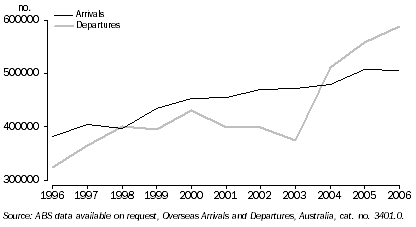
Western Australian overseas departures have also grown at a pace well above what you would expect from general population growth. Between 1996-2006, short-term overseas departures from Western Australia grew 82%, more than four times the rate of population growth (17%). As a result, the ratio of outbound travel to state population fell from one departure per 5.5 residents in 1996 to one departure per 3.5 residents in 2006.
REASONS FOR SHORT-TERM OVERSEAS TRAVEL
The most popular reason for short-term overseas travel to and from Western Australia is holiday travel. Every second journey, whether it be an arrival to Western Australia or departure from the state, is for holiday purposes. Holiday travel as a proportion of total travel declined between 1996-2003, but recovered strongly after that time. The next most popular reasons for travel were visiting friends or relatives and business, accounting for almost one-quarter and one-tenth of total Western Australian travel (inward plus outward) respectively. Other reasons for travel included education, employment and conventions or conferences.
REASONS FOR TRAVEL, Total travel (arrivals plus departures)
- Western Australia
- 1996 to 2006
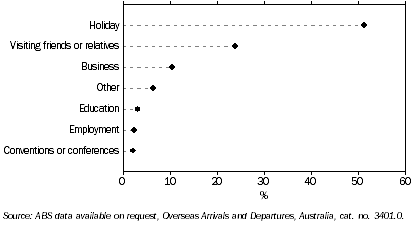
SHORT-TERM OVERSEAS ARRIVALS
Over the ten years to 2006, half (50%) of all short-term overseas arrivals to Western Australia were for holidays. The proportion of holiday arrivals decreased however, from 56% in 1996 to 47% in 2006, despite the number of holiday arrivals rising 12% (24,789) to 239,821. The second most popular reason for travel to Western Australia was visiting friends or relatives, accounting for over one-quarter (26%) of arrivals to Western Australia over the period. The third most popular reason for travel was shared between business travel and other travel, both comprising 8% of arrivals over the ten years. Both of these travel types showed rising proportions between 1996-2006, with business travel up from 7% to 10% and other travel up from 4% to 5%. The remaining reasons for short-term overseas travel to Western Australia included: education (5%), conventions or conferences (2%) and employment (2%) - all showing increased proportions over the ten year period. The two most notable rises were for business travel (7% to 10%) and employment travel (1% to 3%), reflecting the strong performance of the Western Australian economy and the need for labour to help alleviate the state's skills shortage.
SHORT-TERM OVERSEAS DEPARTURES
Over half (53%) of all short-term overseas departures from Western Australia were for holidays between 1996-2006. The proportion of holiday departures decreased slightly, from 54%to 53% over the period, despite the number of holiday departures rising 78% (136,769) to 312,289. The second most popular reason for travel overseas was visiting friends or relatives, accounting for just under one-quarter (22%) of Western Australian overseas departures from 1996-2006. The third most popular reason for travel was business, accounting for 13% of departures over the ten years. The proportion of Western Australians visiting friends or relatives (22% to 23%) remained fairly steady between 1996-2006, while business travel fell from 14% to 13%. The remaining reasons for Western Australians travelling overseas included: other travel (5%), employment (3%), conventions or conferences (3%) and education (1%) - other travel (3% to 5%) and employment travel (3.0% to 3.2%) showed increased proportions and conventions or conferences (3% to 2%) and education (1.1% to 1.0%) showed decreased proportions over the ten years.
FACTORS AFFECTING OVERSEAS TRAVEL
The willingness of people to travel overseas is highly dependant on domestic economic conditions and safety. Higher employment and incomes improve the capacity of people to travel abroad, while world events that cause social-political, economic or environmental instability deters travel. Other economic conditions that influence overseas travel include the price of travel and accommodation and the strength of the local currency.
EMPLOYMENT AND INCOMES
Job security and adequate income can influence holiday plans and destinations. Western Australia has enjoyed a lengthy period of employment growth over the last ten years, with 27% (230,217) more people employed in 2006 than in 1996. Furthermore, when looking at the ratio of employment to population in Western Australia, the pattern of change has been very similar to that of Western Australians travelling overseas on holiday. The proportion of employed persons rose sharply to 65% of the state's population in 2006, after many years at around 62% (1996-2004). Similarly, Western Australians departing on overseas holidays jumped 8.2% over the two years to 2006, following an average growth rate of 6.6% per year between 1996-2004.
RATIO OF EMPLOYED PERSONS TO POPULATION(a), Western Australia
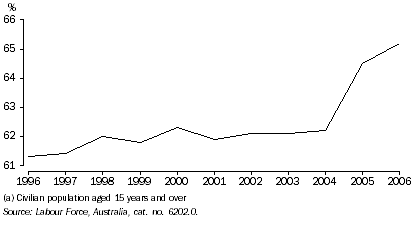 TOTAL SHORT-TERM OVERSEAS DEPARTURES,
TOTAL SHORT-TERM OVERSEAS DEPARTURES, Western Australia
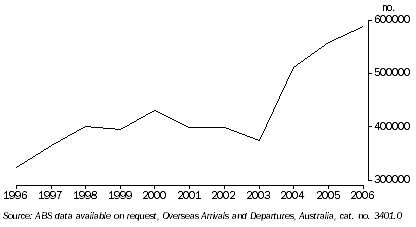
In addition to higher employment, average incomes have grown 31% ($12,648) to $53,134 per year in Western Australia between June 1996-2006, according to real Gross State Product per capita estimates.
REAL GROSS STATE PRODUCT PER CAPITA, Western Australia

Economic conditions have also been favourable in some of the countries from where Western Australia traditionally attracts its overseas tourists. Annual rates of real GDP growth have been solid in the United Kingdom (3%), New Zealand (3%), Hong Kong SAR (4%), Ireland (7%) and the United States of America (3%) between 1996-2006. At the same time these countries have recorded strong increases in holiday travel to Western Australia, ranging from 2,199 (72%) more arrivals from the United States of America to 42,844 (209%) more arrivals from the United Kingdom. In addition, China (up 1,689 or 515%) recorded a notable increase in business travel to Western Australia over the last ten years, reflecting rapid economic growth in that country (9% per year between 1996-2006 on average) and stronger trade relations with Western Australia.
MAJOR WORLD EVENTS
A number of world events have caused significant fluctuation in overseas travel to and from Western Australia in recent times. These events are discussed below in chronological order, not in the order of their impact on overseas travel.
The 1997 Asian financial crisis sent many Asian economies into recession, decreasing the number of people travelling from the region to Western Australia. In the eighteen months to December 1998, short-term travel from South-East Asia fell 21% (36,327 arrivals). Travel from Indonesia was the worst affected, with arrivals down 43% (20,119). Travel was also much lower from Malaysia (down 32% or 13,022) and Thailand (down 37% or 4,181). The largest decline in arrivals outside of the South-East Asian region was from Korea (includes both the Republic of Korea and the Democratic People's Republic of Korea) (down 34% or 925). In contrast to these declines, the number of arrivals for employment increased from these countries in the year following the financial crisis. In 1998, employment travel to Western Australia was higher from Malaysia (up 67% or 60), Indonesia (up 50% or 56), Thailand (up 73% or 30) and Korea (up 19 arrivals, recording its first employment arrivals since 1996).
In 2000, the Fijian Government was overthrown by a military coup culminating in two mutinies. This had an effect on Western Australian travel to Fiji, which dropped 47% in 2001. Once order in Fiji was restored a year later, short-term travel to Fiji rebounded strongly, increasing by an annual average of 128% (960 departures) over the five years to 2006.
Terrorist attacks have been a major factor in reducing overseas travel around the world. The September 11 terrorist attacks on the United States of America in 2001 and the Indonesian (Bali) bombings in October 2002 and 2005 caused major declines in travel to these countries. Short-term travel from Western Australia to the United States of America dropped 27% (6,938 departures) in 2001. In the year following the 2002 Bali bombing, Western Australian travel to Indonesia, which was already at a seven year low, fell by a further 10% (7,584) in 2003. Some confidence in travel to Indonesia returned in 2004, with Western Australian departures increasing 65% (43,138). This confidence was short-lived, however, with the 2004 Boxing Day tsunami and 2005 Bali bombing hampering Western Australian travel to Indonesia in 2006 (down 36% or 40,045).
Natural and biological disasters such as the 2004 Boxing Day tsunami in the Indian Ocean, the 2006 Java earthquakes, the Severe Acute Respiratory Syndrome (SARS) pandemic and the Avian Bird Flu also caused disruptions in travel patterns for many countries. The Boxing Day tsunami in the Indian Ocean affected travel to Western Australia from Thailand (down 13% or 1,529) and Sri Lanka (down 5% or 33) in 2005. Corresponding with the 2006 Java earthquake was a 5% (1,007) fall in arrivals from Indonesia in that year. The 2002 SARS pandemic, which originated in mainland China, saw a decrease of 31% (2,631) in Western Australian travel to China in the year following the outbreak. Similarly, the H5N1 strain of the Avian Bird Flu, which has caused a number of deaths since 2003, also affected travel to many Asian countries.
TRAVEL AND ACCOMMODATION COSTS
Generally, there is an inverse relationship between the cost of holidays and the number of people travelling on holiday. In six of the ten years between 1996-2006, the cost of overseas holidays moved in the opposite direction to the number of overseas holiday departures from Western Australia. This relationship was at its strongest between 2000-2002, when the cost of overseas holiday travel and accommodation increased 30% and short-term holiday departures dropped 15% (35,006). Other factors would have distorted this relationship however. For example, both the price and demand for overseas travel fell in 2003, mainly due to the impact of the 2002 Bali bombing. Also, since 2004, stronger employment and income growth in Western Australia (as well as a higher $A) would have bolstered the demand for overseas holiday travel, despite higher prices.
FOREIGN EXCHANGE RATES
Connected to the cost of overseas travel, the value of a country's currency also influences its overseas travel patterns. Movements in the value of the Australian Dollar ($A) are followed by very similar movements in the number of overseas holiday departures from Western Australia, although holiday travel tends to lag behind currency movements by about one year. Accommodating for the one year lag, the value of the $A against the $US fell 20% in average annual terms from 1999-2002, while the number of holiday departures from Western Australia dropped 24% (55,530) from 2000-2003. Likewise, after this period, the value of the $A grew 48% from 2002 to 2005, while the number of holiday departures increased 76% (135,078) from 2003 to 2006.
GOVERNMENT POLICY
In 1996, the Australian Government implemented a new temporary business visa (Visa 457) allowing people from overseas to work in Australia for up to four years. Between its introduction and 2005, short-term employment arrivals to Western Australia rose 172% (6,825) to 10,785. As a direct response to nationwide labour shortages, Visa 457 was amended in April 2005 to allow more short-term workers into the country, which contributed to a rise of 53% (5,667) in employment arrivals to Western Australia in 2006. As at 30 June 2006, there were 11,237 Visa 457 holders in Western Australia.
The recent growth in employment arrivals has not been enough to meet the increasing number of job vacancies in Western Australia. In 2003, employment arrivals totalled 8,332, a shortfall of 718 arrivals compared to the number of job vacancies on offer during the year (9,050). Over the three years to 2006, employment arrivals grew by a much lower rate than job vacancies, 32% (2,707) compared to 41% (3,425) growth in job vacancies per year. This increased the shortfall to 5,623 in 2006, with 16,452 employment arrivals and 22,075 job vacancies.
SHORT-TERM OVERSEAS EMPLOYMENT ARRIVALS AND JOB VACANCIES, Western Australia

MAJOR CHANGES IN SHORT-TERM OVERSEAS TRAVEL
HOLIDAY TRAVEL
The pattern of overseas travel to and from Western Australia has been shaped over the last ten years by movements in the holiday travel component of total travel. Holiday travel accounts for half of all short-term overseas travel to and from the state. The number of Western Australians departing on overseas holidays has grown to record levels in recent years, while international holidaymaker numbers coming to Western Australia have grown more modestly - holiday departures up 78% (136,769) and holiday arrivals up 12% (24,775) between 1996-2006. There has also been a shift in the destinations to which Western Australians have travelled and the countries from which tourists have come to holiday in Western Australia.
SHORT-TERM OVERSEAS HOLIDAY TRAVEL, Western Australia
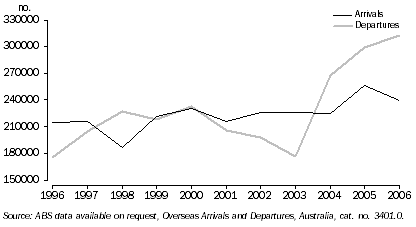
Short-term overseas holiday arrivals
Until recently, Indonesia was one of Western Australia's major sources of overseas tourists. In 1996, 17% (35,960) of holiday arrivals to Western Australia were from Indonesia, second only to Singapore with 22% (46,626). By 2006, only 3% (7,730) of total holiday arrivals were from Indonesia. Tourists from the United Kingdom recorded the largest increase over the last ten years, with the proportion of holidaymakers from the United Kingdom rising from 10% (20,511) in 1996 to 26% (63,355) in 2006.
In 1998, just one year after the onset of the Asian financial crisis, total holiday arrivals to Western Australia dropped 14% (29,475). This slump was almost entirely the result of less holiday travel from Indonesia (down 16,404 or 56%) and Malaysia (down 11,069 or 42%), as well as declines from Thailand (down 4,048 or 49%), Singapore (down 2,409 or 5%), Japan (down 1,778 or 6%) and Korea (down 428 or 49%). Despite the number of holiday arrivals recovering for most countries in 1999 (total arrivals up 35,478 or 19%), the downturn in holidaymakers from Indonesia continued, with arrivals dropping 13% (1,622 ) in that year.
In 2001, there was a notable downturn in holiday travel to Western Australia from Japan (down 23% or 8,001) and Singapore (down 11% or 5,588), which coincided with declines in the value of the Japanese Yen and Singapore Dollar. The drop in holiday arrivals from these countries accounted for almost all of the fall in total arrivals to Western Australia during the year (down 6% or 14,031). The average value of the Japanese Yen and Singapore Dollar were at lows against the $A in 2001, having dropped 14% and 15% respectively from 1999. However, in 2002, the Yen (up 8%) and Singapore Dollar (up 2%) appreciated against the $A, which saw a recovery in holiday travel from Japan (up 18% or 4,607), but the marginal rise in the Singapore Dollar was not enough to encourage more holiday travel from Singapore (down 2% or 1,051).
Western Australia experienced a surge in overseas visitors in 2005, with holiday arrivals increasing 14% (30,843) to a record high of 255,763 arrivals. About half of this growth was attributed to holiday travel from Singapore (up 44% or 15,416). However this growth was short-lived as holiday arrivals from Singapore dropped 30% (15,088) in 2006.
Short-term overseas holiday departures
Overseas holiday costs appears to have had a greater effect on Western Australian travel between 1996-2002 than in later years, mainly due to a stagnating local economy during that time. In the two years to 2002, Western Australians departing on overseas holidays fell 15% (35,006), as the cost of overseas holiday travel and accommodation rose 30%. However, since 2003, with the state economy improving rapidly, the cost of holiday travel and accommodation had much less of an effect. Between 2003-2006, overseas holiday departures from Western Australia grew 76% (135,078), despite a rise in travel and accommodation prices of 5%.
There has been some change in the preferred overseas holiday destinations of Western Australians in the last ten years. In 1996, almost half of all holiday departures were either to Indonesia (37%) or the United Kingdom (12%). Indonesia, despite remaining the most preferred holiday destination, lost many holidaymakers from Western Australia since the two Bali bombings. After the latest bombing in 2005, there was a drop in the proportion of Western Australian holiday departures to Indonesia from 30% (90,441) in 2005 to 16% (51,271) in 2006. It appears as though many Western Australians substituted holiday travel from Indonesia to Thailand, as the proportion of holiday travel to Thailand rose from 8% (25,113) in 2005 to 14% (43,656) in 2006.
SHORT-TERM OVERSEAS HOLIDAY DEPARTURES TO INDONESIA AND THAILAND, Proportion of total holiday departures, Western Australia

After the terrorist attacks in the United States of America on 11 September 2001, Western Australians became increasingly cautious about travelling overseas and holiday travel decreased to most major destinations. Total holiday departures decreased by an average of 8% (18,510) per year between 2000-2003. Holiday departures to the United States of America dropped 47% (5,295) in 2001. In 2002, departures to the popular holiday destinations of Indonesia, Singapore and Malaysia decreased by a combined 15% (18,268) - a decline also influenced by the SARS threat in the region. There was no recovery in travel to South-East Asia in the following year (2003), as the October 2002 Bali bombing, SARS and the Marriott Hotel bombing in Jakarta continued to deter many would be travellers. The combined effect of these events saw a 14% (14,721) decrease in departures to Indonesia, Singapore and Malaysia in 2003. Holiday travel to Thailand (down 35% or 8,566) and the United Kingdom (down 6% or 1,158) were also much lower during the year.
After 2003, overseas holiday travel from Western Australia rose at a rapid rate. In 2004, 51% more Western Australians departed on overseas holidays than a year earlier, with travel increasing to all major destinations, including a major recovery to the South-East Asian region. Holiday travel to Indonesia alone increased 83% (41,633) in 2004. By 2005, holiday travel recovered to all major destinations, although travel to Indonesia fell marginally (down 2%), possibly due to the effects of the Boxing Day tsunami at the end of 2004. Holiday travel to Indonesia continued to suffer after the second Bali bombing in October 2005, with holiday travel to Indonesia declining 43% (39,170) in 2006. Overall, since 2003, Western Australian holiday travel increased the most to Thailand (up 174% or 27,705), Singapore (up 114% or 16,361) and Malaysia (up 171% or 15,514).
VISITING FRIENDS OR RELATIVES
In each year between 1996-2006, the number of arrivals to Western Australia for the purpose of visiting friends or relatives has exceeded the number leaving Western Australia for the same purpose. Over the last few years, however, the number of locals departing overseas to visit friends or relatives has grown much faster than those coming to Western Australia to visit friends or relatives, which has almost closed the gap between the two. Like holiday travel, overseas visitor travel to and from Western Australia has reached ten-year highs in the last two years.
SHORT-TERM OVERSEAS VISITOR TRAVEL, Western Australia

Short-term overseas visitor arrivals
A large number of people from the United Kingdom visit friends or relatives in Western Australia. This is not surprising given that the United Kingdom (comprising England, Scotland and Wales) accounts for well over one-third (39% in 2006) of Western Australian residents born overseas. Over the ten years to 2006, travellers from the United Kingdom made up over 35% of total visitor arrivals to Western Australia. In 2006, there were 52,678 travellers from the United Kingdom, representing 38% of total visitor arrivals during the year. The second largest proportion of travellers visiting friends or relatives were from New Zealand in 2006 (12% of total visitor arrivals or 17,110 persons). Almost one-tenth (9%) of overseas born Western Australian residents were born in New Zealand in 2006.
After two years of decline, there was a steady increase in overseas residents visiting friends or relatives in Western Australia from 2002-2006. Visitor arrivals dropped by an average of 6% (7,451) per year between 2000-2002, mainly due to large falls in visitors from New Zealand (down 5,181 or 30%), the United Kingdom (down 2,526 or 6%) and Malaysia (down 1,550 or 21%). From 2002-2006, total visitor arrivals increased by an average of 8% (8,004) per year, with a large rebound in travellers from the United Kingdom (up 11,543 or 28%), New Zealand (up 5,237 or 44%) and Malaysia (up 1,623 or 29%).
Short-term overseas visitor departures
Similar to inbound visitor travel, the United Kingdom was the major destination for Western Australians travelling overseas to visit friends or relatives over the ten years to 2006. About one-in-five visitor departures over this time were to the United Kingdom, although the proportion of departures decreased slightly. In 2006, 21% of Western Australian travellers visited friends or relatives in the United Kingdom, compared to 24% ten years earlier. This decline could well be linked to the fall in the proportion of Western Australian residents born in the United Kingdom, down from 45% in 1996 to 41% in 2006. New Zealand ranked second in terms of the proportion of total visitor departures from Western Australia in 2006 with 16%.
The number of Western Australians visiting friends or relatives overseas has surged in the last three years. Following a fall of 9% (8,760) in 2001, the number of visitor departures from Western Australia rose 12% (10,756) per year on average between 2002-2006. Visitor departures increased to most countries over this period, with the major increases being to New Zealand (up 8,451 or 70%) and the United Kingdom (up 7,463 or 36%).
BUSINESS TRAVEL
The Western Australian economy relies heavily on international markets for the goods and services it produces, with around 40% of total production shipped offshore each year. As a result, many Western Australians travel overseas on business and many business people come to Western Australia (although not nearly to the same extent). Over the last ten years, there were around twice as many business departures from Western Australia than business arrivals. The gap between the two widened slightly over the ten years to 2006, as the number of business departures (up 30,790 or 70%) grew by more than the number of business arrivals (up 24,797 or 90%).
SHORT-TERM OVERSEAS BUSINESS TRAVEL, Western Australia

A shift has occurred in the countries with which Western Australia shares its business travel. In 1996, business travel between Western Australia and Indonesia totalled 10,350, with 2,050 arrivals and 8,300 departures, accounting for 14% of total business travel in that year. By 2006, business travel to and from Indonesia dropped 16% to a total of 8,649, with 1,987 arrivals and 6,662 departures, accounting for a much lower 7% of total business travel. This decline was mainly the result of the emergence of China as a major trading partner for Western Australia, as well as the reduced confidence in travelling to Indonesia. Western Australia currently shares the largest proportion of its business travel with Singapore, accounting for 15% (18,630) of total business arrivals (8,278) and departures (10,352) in 2006.
The stronger economic ties between Western Australia and the rapidly growing Chinese economy has been reflected in business travel between the two countries. The state's total trade with China (exports and imports) more than tripled (up 266% or $4.2 billion) between 1996-2004 and business travel (arrivals plus departures) rose 200% (4,101). In the following two years (2004-2006), growth accelerated even further, with international trade up 128% ($7.3 billion) and business travel up 49% (3,020 arrivals and departures) between these two nations.
SHORT-TERM OVERSEAS BUSINESS TRAVEL TO AND FROM CHINA, Western Australia

Business travel between Western Australia and India has also grown substantially in recent years. From 2002-2006, business travel between the two nations rose 177% (1,674), as Western Australia's trade with India grew from $490 million to $4.4 billion over the period.
Another country recording a greater level of business travel with Western Australia was the United Arab Emirates. In 1996, the United Arab Emirates ranked as Western Australia's thirty-first highest business travel partner with 283 arrivals and departures combined. However, by 2006, its rank rose to fourteenth highest, with 2,225 business arrivals and departures, an increase of 194 (69%) arrivals and departures per year on average.
EMPLOYMENT TRAVEL
Western Australia has experienced seven years of sustained economic growth since 2000, which has increased the proportion of people employed in the state. As economic growth accelerated, particularly over the last three years, the state's labour supply was placed under increased pressure to meet labour demand, resulting in a major shortage of skilled workers in the state. The movement of people to and from the state for short-term employment was influenced by these labour market conditions. For example, the number of employment departures from Western Australia to other countries stagnated from 2004, as job prospects and wages became more favourable in the state. On the other hand, many short-term overseas workers arrived in the state in 2006, due to greater employment opportunities and changes to immigration policy. In the four years to 2006, job vacancies grew 164% (13,700) in Western Australia.
SHORT-TERM OVERSEAS EMPLOYMENT TRAVEL, Western Australia

Over the last ten years, there have been more short-term employment arrivals to, and departures from, Western Australia. Outward employment travel rose by an average of 9% (909 departures) per year between 1996-2006. However, as wages and the severity of the state's skills shortage grew, the rate of employment departures decelerated to 2% (352) per year in the last two years of the period (2004-2006).
Inward overseas employment travel grew 17% (683 arrivals) per year on average between 1996-2005. After the amendment to the temporary business visa (Visa 457) in 2005, employment travel to Western Australia increased 53% (5,667 arrivals) during the year. The rise in employment arrivals was consistent with research conducted by the Parliamentary Library of Australia, which found that the number of Visa 457s issued for Australia increased 44% from 2004-05 to 2005-06 - this increase relates only to primary 457 visas issued to workers, excluding any family members which may arrive with them.
Short-term overseas employment arrivals
There has been considerable change in the countries from which people have come to Western Australia for short-term employment. In 1996, the majority of workers came from either New Zealand (41% or 1,604) or the United Kingdom (21% or 831). However, over the next ten years, the proportion of workers from New Zealand and the United Kingdom fell to 17% (2,864) and 13% (2,063) respectively in 2006. It was mainly an increase in workers from Singapore, Malaysia and Indonesia in the last three years that has reduced these shares. The proportion of employment arrivals from Singapore rose from 5% (446) in 2003 to 17% (2,745) in 2006. The proportion of workers from Malaysia increased from 3% (284) to 8% (1,340), and rose from 4% (373) to 7% (1,158) from Indonesia over the three years. In number terms, there were 2,299 more arrivals from Singapore, 1,056 more arrivals from Malaysia and 785 more arrivals from Indonesia between 2003-2006.
Short-term overseas employment departures
The number of Western Australians travelling abroad for short-term employment levelled off between 2004-2006, as the shortage of skilled workers increased and local incomes became more internationally competitive. The number of employment departures from Western Australia rose by an average of 2% (352) per year over this time, much lower than the 9% (909) average annual growth over the entire ten years to 2006. The countries to which Western Australian residents have travelled have remained much the same over the last ten years, although a couple of countries have grown in significance.
In 2006, Singapore was the most popular short-term employment destination for Western Australians, accounting for 13% (2,396) of total overseas departures in that year. Indonesia (10% or 1,871) and the United Kingdom (10% or 1,794) were the next most popular destinations. These countries were also the main destinations for short-term employment in 1996: the United Kingdom (15% or 1,448), Singapore (15% or 1,418) and Indonesia (10% or 966).
An increasing number of Western Australians have travelled to the United Arab Emirates for short-term employment in recent years. With oil reserves diminishing, the United Arab Emirates has begun restructuring its economy toward alternate industries such as developing Dubai into a major tourist destination and transport hub. The associated engineering and building construction activity has brought many international workers to Dubai, attracted by higher incomes and tax-free employment packages. In 1996, there were 36 short-term employment departures from Western Australia to the United Arab Emirates. Since then, employment departures have grown by an average of 63 per year to 664 departures in 2006. As a result, the proportion of Western Australian employment travel to the United Arab Emirates has risen from 0.4% in 1996 to 3.5% in 2006.
Sub-Saharan Africa (excluding South Africa and Mauritius) has also emerged as a major destination for Western Australian short-term employment. Between 1996-2006, the proportion of Western Australian employment departures to this region tripled from 2% (205) to 6% (1,056) of total departures. According to the International Monetary Fund, real GDP growth in Sub-Saharan Africa increased from 3.5% in 2002 to 5.4% in 2006, while peaking at 6.0% in 2004 and 2005. Economic growth in this region has been driven by strong world demand for oil. Higher oil prices have led to greater investment in expanding oil production and export capacity in Sub-Saharan Africa. Large resource-based projects, primarily funded by Chinese investment, have attracted many workers to the region to assist with the development of new oil fields and refineries, iron ore mines and other infrastructure such as railways and ports.
EDUCATION TRAVEL
Western Australia has attracted an increasing number of international students in recent times. According to the Australian Department of Education, Science and Training, the number of overseas student enrolments rose 21% (5,596) in Western Australia, from 27,034 to 32,630 between 2002-2006. Just over half of all enrolments become commencements, and hence, international student commencements rose from 16,267 to 17,752 (up 9% or 1,465) over the shorter time period of 2004-2006. These figures are consistent with the solid growth shown in overseas education arrivals to Western Australia since 1998.
OVERSEAS STUDENT ENROLMENTS, Western Australia
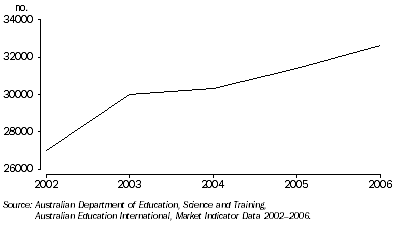
Furthermore, far fewer Western Australians travel overseas for education purposes than overseas students arrive in the state (5,817 compared to 26,050 in 2006), although the number of residents departing for overseas education have grown significantly in the last three years.
Short-term overseas education arrivals
The number of education arrivals to Western Australia has risen over the last ten years, from 19,042 in 1996 to 26,050 in 2006, mainly from China (up 1,849% or 1,442), Korea (up 102% or 766), Singapore (up 18% or 696) and Japan (up 45% or 623). There has been some fluctuation however and a distinct slowing in the rate of growth since 2001. A spike in education arrivals occurred in 1997, due to sharp increases in overseas students from Indonesia (up 32% or 1,505) and Malaysia (up 52% or 1,276). In the following year (1998), education arrivals declined from these two countries: Indonesia (down 34% or 2,109) and Malaysia (down 31% or 1,173). Then, from 1998-2001, education arrivals increased strongly at an average rate of 10% (1,910) per year, with the United States of America (up 147% or 1,099), Singapore (up 11% or 493) and China (up 174% or 489) accounting for a large proportion of the increased travel. From 2001-2006, however, growth in education arrivals to Western Australia slowed considerably, increasing by an average of only 1% (195) per year.
SHORT-TERM OVERSEAS EDUCATION ARRIVALS, Western Australia

In 2006, there were 26,050 international students arriving in Western Australia, with over one-quarter coming from the countries of Singapore (17% or 4,463) and Malaysia (11% or 2,879). This represents a considerable change from 1996, when one-in-four education arrivals were from Indonesia (24% or 4,648). After reaching a high of 6,153 arrivals in 1997, students arriving from Indonesia have dropped steadily, at an average of 7% (460) per year over the subsequent nine years.
Short-term overseas education departures
The number of Western Australians travelling overseas for education has been sporadic over the last ten years, although there has been a general upward trend. Between 1996-2006, education departures from Western Australia rose 62% (2,222) to 5,817. Three major peaks in education departures occurred in 1997 (4,078), 2001 (5,211) and 2004 (5,925), with each peak steadily increasing over time. Some of the more notable periods of increase in education departures occurred between 1999-2001 (up 41% or 1,502 ) and in 2004 (up 42% or 1,754). From 1999 to 2001, there were large rises in Western Australian students travelling to Indonesia (up 127% or 482), New Zealand (up 162% or 386) and Malaysia (up 684% or 383). In 2004, the destinations of China (up 1,041% or 302) and New Zealand (up 93% or 267) attracted more Western Australian students.
SHORT-TERM OVERSEAS EDUCATION DEPARTURES, Western Australia

There has been some change in the destinations to which Western Australians have travelled for overseas education in the last decade. In 1996, over one-in-five education departures were to Indonesia (21% or 758), while 10% (376) went to Singapore and 9% (335) went to the United Kingdom. However, by 2006, apart from a high proportion of Western Australians still travelling to Singapore (21% or 1,245) for education, New Zealand (9% or 534) and Japan (8% or 467) emerged as the second and third most popular destinations for Western Australian students.
CONVENTION OR CONFERENCE TRAVEL
Western Australia's booming economy has meant that business, government and educational institutions have had more funds available to send people overseas to attend conventions or conferences. Conversely, Western Australia's rising international trade in minerals and energy has seen more people come to the state for conventions or conferences. The completion of the Perth Convention Centre in 2004 also coincided with more convention or conference arrivals after that time. Given Perth's relative isolation from the rest of the world, it is not surprising that there are more convention or conference departures from Western Australia than there are arrivals for the same purpose. In 2006, there were 13,312 Western Australians departing for overseas conventions or conferences and 9,943 persons arriving from overseas for conventions or conferences held in Western Australia - 25% (3,369) less arrivals than departures.
SHORT-TERM OVERSEAS CONVENTION OR CONFERENCE TRAVEL, Western Australia
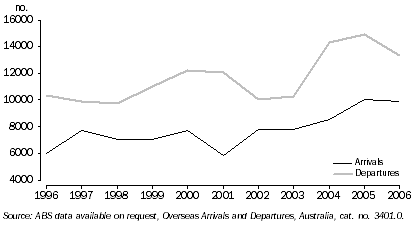
Short-term overseas convention or conference departures
After a short period of decline, the number of departures from Western Australia for overseas conventions or conferences jumped 46% (4,734) between 2003-2005, followed by a fall of 11% (1,647) in 2006. The largest annual increase was recorded in 2004, with convention or conference departures rising 40% (4,097) to 14,322. This increase was across many destinations, with the most prominent being the United Kingdom (up 115% or 599), New Zealand (up 29% or 446), Malaysia (up 71% or 425) and the United States of America (up 22% or 424). Growth in convention or conference departures slowed in the following year (2005), increasing by only 4% (637). The fall in convention or conference departures in 2006 was mainly due to less travel to New Zealand (down 44% or 945), Malaysia (down 30% or 265) and Singapore (down 15% or 227).
Over the last ten years, there were notably more Western Australians attending conventions or conferences in China. Between 1996-2006, convention or conference travel to China increased by an average of 79 departures (158%) per year, to become the state's fifth largest convention or conference destination in 2006. Much of this rise can be attributed to the strengthening of trade relations between the two nations. Despite the emergence of China, the United States of America remained the most popular destination for Western Australian overseas convention or conference travel, accounting for 19% (2,475) of total convention or conference departures in 2006. The next most popular destinations were Singapore (10% or 1,338) and New Zealand (9% or 1,201).
Short-term overseas convention or conference arrivals
Recently, the pattern of people arriving from overseas for conventions or conferences in Western Australia has been similar to that of Western Australians departing for conventions or conferences overseas. Between 2003-2005, convention or conference arrivals rose 29% (2,291) and dropped 1% (123) in 2006. In 2004, the year the Perth Convention Centre was opened, overseas arrivals to Western Australia for conventions or conferences rose 10% (753). In the following year (2005), they grew by a further 18% (1,538).
People arriving from China to attend conventions or conferences in Western Australia grew strongly between 1996-2006, rising by an average of 43 (83%) per year, with much of the growth occurring since 2002. In 2006, New Zealand accounted for the largest proportion of convention or conference arrivals to Western Australia (18% or 1,794), followed by the United Kingdom (11% or 1,110) and the United States of America (10% or 1,031).
 Print Page
Print Page
 Print All
Print All